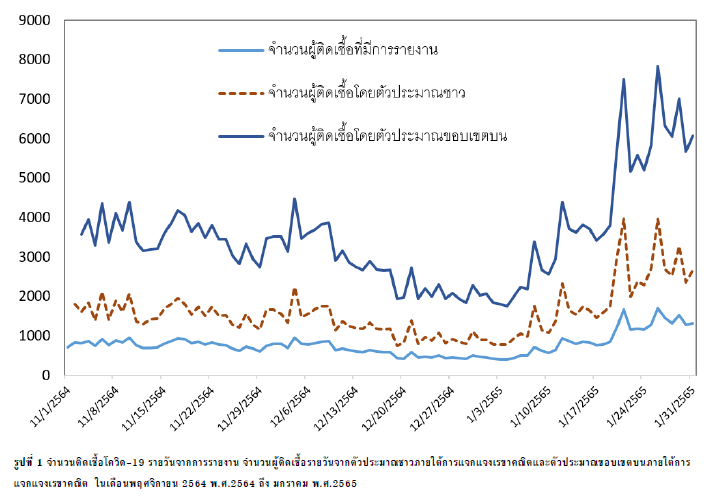Estimating the number of COVID-19 infected cases in Bangkok by capture-recapture method
Keywords:
population size estimation, coronavirus, asymptomatic, ndetectedAbstract
Capture-recapture method is widely used in a variety of fields including epidemiology to estimate the size of difficult-to-explore populations. Many people are asymptomatic after contracting COVID-19, resulting in a significant number of concealed infections. This study applied capture-recapture method to estimate the total number of infected populations in Bangkok from November 2021 to January 2022 using Chao lower bound estimator and upper bound estimator under geometric distribution. When the lower bound estimates were taken into account, it was discovered that there were 46,134, 35,427, and 58,083 cases in November, December, and January, respectively, representing 2.0249, 2.0089, and 2.0711 times the number of infected reported by the Department of Disease Control. According to the upper bound estimator, there were 99,258, 76,443, and 125,377 cases in November, December, and January, respectively, representing 4.3567, 4.3347, and 4.4707 times the number of infections reported by the Department of Disease Control.
References
Alfò, M., Böhning, D., & Rocchetti, I. (2021). Upper bound estimators of the population size based on ordinal models for capture‐recapture experiments. Biometrics, 77(1), 237-248.
Böhning, D., Rocchetti, I., Maruotti, A., & Holling, H. (2020). Estimating the undetected infections in the Covid-19outbreak by harnessing capture–recapture methods. International Journal of Infectious Diseases, 97, 197-201.
Efron, B., & LePage, R. (1992). Introduction to bootstrap. (pp. 3-10). Wiley & Sons.
Lanumtaeng, K.,&Bohning, D. (2011). An extension of Chao’s estimator of population size based on the first three capture frequency counts. Computational Statistics and Data Analysis, 55, 2302-2311.
Lerdsuwansri, R., Sangnawakij, P., Böhning, D., Sansilapin, C., Chaifoo, W., Polonsky, J. A., & Del Rio Vilas, V. J. (2022) Sensitivity of contact-tracing for COVID-19in Thailand: a capture-recapture application. BMC Infectious Diseases, 22(1), 1-10.
Nguyen, L. T., Patel, S., Nguyen, N. T., Gia, H. H., Raymond, H. F., Hoang, V. T. H., & Abdul-Quader, A. S. (2021). Population Size Estimation of Female Sex Workers in Hai Phong, Vietnam: Use of Three Source Capture–Recapture Method. Journal of Epidemiology and Global Health, 11(2), 194.
Niwitpong, S. A., Böhning, D., van der Heijden, P. G., & Holling, H. (2013). Capture–recapture estimation based upon the geometric distribution allowing for heterogeneity. Metrika, 76(4), 495-519.
Pawitan, Y. (2001). In all likelihood: statistical modelling and inference using likelihood. Oxford University Press.
Pijitrattana, J., Lerdsuwansri, R., & Böhning, D. (2020). Profile Confidence Interval for Population Size Based on Poisson-Normal Mixture Models. Proceedings of International Conferencein Mathematics and Applications Mahidol University (ICMA-MU2020)(pp. 119-128).
Rocchetti, I., Böhning, D., Holling, H., & Maruotti, A. (2020). Estimating the size of undetected cases of the COVID-19outbreak in Europe: an upper bound estimator. Epidemiologic Methods, 9(s1).
Van Der Heijden, P. G., Bustami, R., Cruyff, M. J., Engbersen, G., & Van Houwelingen, H. C. (2003). Point and interval estimation of the population size using the truncated Poisson regression model.Statistical Modelling, 3(4), 305-322.

Downloads
Published
License
Copyright (c) 2023 Journal of Applied Science and Emerging Technology

This work is licensed under a Creative Commons Attribution-NonCommercial-NoDerivatives 4.0 International License.

